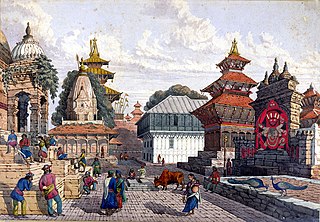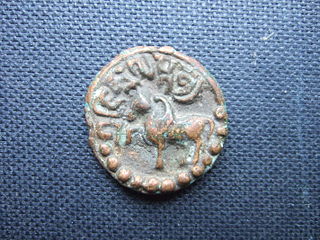
Kathmandu, officially Kathmandu Metropolitan City, is the capital and most populous city of Nepal with 845,767 inhabitants living in 105,649 households as of the 2021 Nepal census and approximately 4 million people in its urban agglomeration. It is located in the Kathmandu Valley, a large valley in the high plateaus in central Nepal, at an altitude of 1,400 metres.

Nepal is a multi-ethnic, multiracial, multicultural, multi-religious, and multilingual country. The most spoken language is Nepali followed by several other ethnic languages.

Newar, known officially in Nepal as Nepal Bhasa, is a Sino-Tibetan language spoken by the Newar people, the indigenous inhabitants of Nepal Mandala, which consists of the Kathmandu Valley and surrounding regions in Nepal. The term "Newari" is also used to refer to the language, although it is considered to be a derogatory term by some Newar speakers.

The unification of Nepal was the process of building the modern Nepalese state, from fractured petty kingdoms including the Baise Rajya and the Chaubisi Rajya, which began in 1743 AD. The prominent figure in the unification campaign was Prithvi Narayan Shah, King of Gorkha. On 25 September 1768, he officially announced the creation of the Kingdom of Nepal and moved his capital from Gorkha to the city of Kathmandu.

The Malla dynasty also known as the Malla confederacy, was the ruling dynasty of the Kathmandu Valley in Nepal from 1201 to 1779. This dynasty was founded by Arideva Malla. Though the latter Mallas were regarded as belonging to the Raghuvamsha dynasty, they were also seen as continuations and descendants of the Licchavi dynasty. Later Malla kings also traced one section of their lineage from Nanyadeva, the founder of the Karnat dynasty of Mithila. The term malla means wrestler in Sanskrit. The first use of the word malla in the Kathmandu Valley began in 1201.
The Abhiras were a legendary people mentioned in ancient Indian epics and scriptures as early as the Vedas. they were a warlike tribe is admitted by all. Probably they were a nomadic people as they are associated with various peoples and provinces. A historical people of the same name are mentioned in the Periplus of the Erythraean Sea. The Mahabharata describes them as living near the seashore and on the bank of the Sarasvati River, near Somnath in Gujarat.
Gopa or Gop or Gope is a synonym of the Yadav (Ahir) caste. It is generally used as a title by the Ahir caste in the states of Bihar, Jharkhand and West Bengal of East India and even in Terai region of Nepal.

The architectural heritage of Kathmandu city is integral to that of the Kathmandu valley since all monuments have evolved over centuries of craftsmanship influenced by Hindu and Buddhist religious practices. The architectural treasure of the Kathmandu valley has been categorized under the well known seven groups of heritage monuments and buildings. In 2006, UNESCO declared these seven groups of monuments as a World Heritage Site (WHS). The seven monuments zones cover an area of 188.95 hectares, with the buffer zone extending to 239.34 hectares. The Seven Monument Zones (Mzs) inscribed originally in 1979 with a minor modification in inscribed year as 2006, are: Five monuments in Kathmandu – Durbar square of Hanuman Dhoka, Hindu temples of Pashupatinath and Changunarayan, the Buddha stupas of Swayambu and Boudhanath; and two monuments outside Kathmandu city limits, in the satellite towns of Patan and Bhktapur – Durbar square at Patan, Durbar square at Bhaktapur. Brief details of the five Kathmandu city monuments are elaborated here.

The Battle of Bhaktapur was the final campaign in the Gorkha conquest of Nepal. It took place in Bhaktapur in 1769, and resulted in the victory of the Gorkhali king Prithvi Narayan Shah, giving him control of the entire Kathmandu Valley and adjoining areas.

Khasa-Malla kingdom, popularly known as Khasa Kingdom and Yatse in Tibetan, was a medieval kingdom from the modern day far-western Nepal and parts of Uttarakhand state in India, established around the 11th century. It was ruled by kings of Khasa tribe who bore the family name "Malla". The Khasa Malla kings ruled western parts of Nepal during 11th–14th century. The 954 AD Khajuraho Inscription of Dhaṇga states that the Khasa Kingdom were equivalent to the Gaudas of Bengal and the Gurjara-Pratihara dynasty.
The Gopal Raj Vamshavali is a 14th-century hand-written manuscript of Nepal which is primarily a genealogical record of Nepalese monarchs.
Tularam Pande was a Nepalese military personnel, diplomat and politician in the Gorkha Kingdom. He was a diplomat who served King Prithvi Narayan Shah of Gorkha. Two of his diplomatic missions were with Dolakha and Kathmandu while the latter remained unsuccessful. He also served as the national military commanders in the forces of Prithvi Narayan Shah. He was the patron of the Gora Pande clan, a minor faction of the Gorkha-based aristocratic Pande family. Some of his patrilineal descendants became influential politicians such as Ranajit Pande and Dalabhanjan Pande in the Nepalese history through their marital ties with the Thapa dynasty. His matrilineal descendants became significantly influential; Queen Tripurasundari of Nepal went on to become Queen Mother of Nepal and Mathawar Singh Thapa – the Prime Minister of Nepal and Jang Bahadur Kunwar Ranaji – the latter period ruler of Kaski and Lamjung and Prime Minister of Nepal.
The Himalayan country named Nepala with its capital in Kathmandu Valley was well-known in the Indian sub-continent by at least 2,500 years ago. Historical discussions on the etymology of Nepal incorporated elements of Hindu and Buddhist History. The origin of the term Nepal is an area of ongoing investigation. Multiple hypotheses have been put forward by modern scholars to varying level of support. It is generally accepted that Nepal and Newar—the latter refers to the ethnic group indigenous to the Kathmandu Valley—are different forms of the same word.
The Char Dham of Nepal is a set of four Hindu religious sites in Nepal. They are Pashupat Kshetra, Mukti Kshetra, Ruru Kshetra and Baraha Kshetra.

The Mahisapala Dynasty also known as the Ahir dynasty was a dynasty established by an Abhira that ruled the Kathmandu Valley. They were also known as Mahispalbanshi. They took control of Nepal after replacing the Gopala dynasty. The Gopalas and the Mahisapalas were together known as Abhiras. Three kings of Mahisapala dynasty ruled the valley before they were overthrown by the Kiratas.

Thakuri dynasty was a Hindu dynasty that mostly ruled the present-day region of Nuwakot, near central Nepal. The Thakuri dynasty's existence is disputed by some historians.Available inscriptions and copperplates indicate that Classical Newari was the state language during the Thakuri dynasty. When the Lichchavi rule ended and the rule of Thakuris began, the native Newars, who were descendents of the Lichchavis and Kirats were mostly following Shaiva tantric sect and Buddhist Tantric sect during Thakuri dynasty.
In the 11th century, a powerful empire of Khas people emerged in western Nepal whose territory at its highest peak included much of western Nepal as well as parts of western Tibet and Uttarakhand of India. By the 14th century, the empire had splintered into loosely associated Baise rajyas, literally 22 states as they were counted. The rich culture and language of the Khas people spread throughout Nepal and as far as Indo-China in the intervening centuries; their language, later renamed the Nepali language, became the lingua franca of Nepal as well as much of North-east India. In south-eastern Nepal, Simraungarh annexed Mithila around 1100 AD, and the unified Tirhut stood as a powerful kingdom for more than 200 years, even ruling over Kathmandu for a time. After another 300 years of Muslim rule, Tirhut came under the control of the Sens of Makawanpur. In the eastern hills, a confederation of Kirat principalities ruled the area between Kathmandu and Bengal.

Ripu Malla was the Maharajadhiraja of the Khasa Kingdom who reigned in the early 14th century. He is best remembered for being the last visitor to Lumbini, the birthplace of the Gautama Buddha that left an inscription of his visit.

The Abhira-Gupta Dynasty also known as the Ahir-Gupta dynasty was a dynasty which existed in the Kathmandu Valley in modern-day Nepal. These Abhira-Guptas had overshadowed the Licchavi kings in the administration. Ravigupta, Bhaumagupta, Jishnugupta and Vishnugupta of Abhira-Gupta family controlled Kathmandu (Nepal) as de facto-ruler during many Lichchhavi kings.
Yadavs of Nepal, also known as Ahir or Gope are one of the prominent caste of Nepal. According to the 2021 Nepal census, 1,228,581 people are Yadav.








